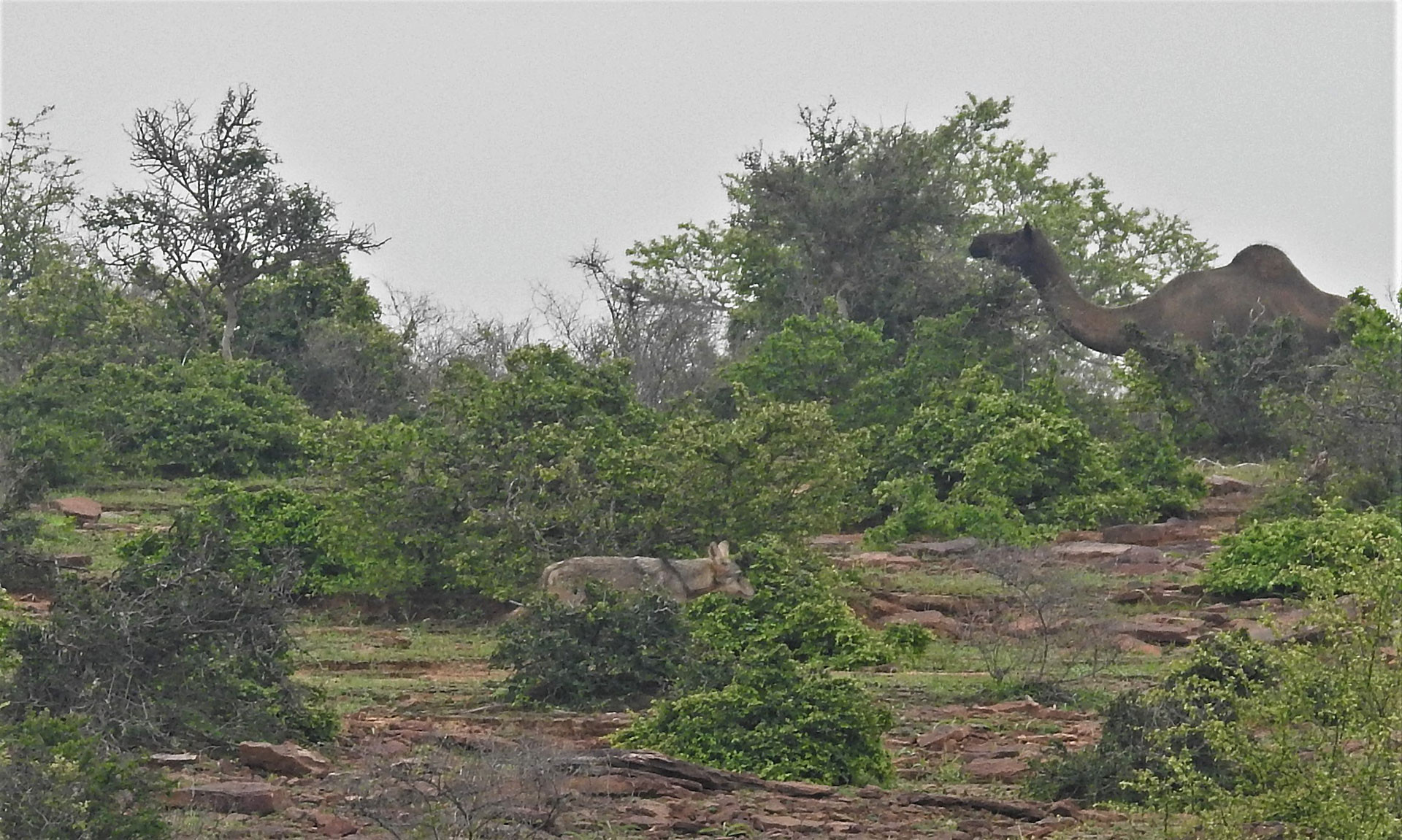"Sir! Sir! A pack of seven…eight wolves!" my field assistant Harimohan shouted in excitement. It was a scorching day at the Kailadevi Wildlife Sanctuary (KWLS), where we were on the lookout for any signs of the Indian Grey Wolf. Panning my binoculars in the general direction he was pointing at, I spotted a lone wolf, followed by three and then four more from behind a caravan of camels. The pack was at quite a distance from us. It was remarkable that he had spotted them. We tried to sneak up to the pack, but as expected, the agile canids outran us and disappeared into the mirage created by the harsh afternoon heat. It was my first encounter with the Indian Grey Wolf, the apex predator of this semi-arid habitat in the Karauli district of Rajasthan.
After completing my masters in wildlife sciences, I got the wonderful opportunity to work with an NGO named Tiger Watch on the Indian Wolf. The objective of the project was to assess the ecological status of the Indian Wolf in KWLS with a focus on anthropogenic interactions. KWLS is a beautiful landscape with gorges, valleys, and breathtaking waterfalls. Currently, there are around 60 villages inside KWLS, but despite the anthropogenic pressures, the sanctuary boasts a rich faunal diversity. We started our field expedition with eight field assistants and a cook, all travelling in a 4x4 Mahindra jeep packed to the brim with all our essentials, sleeping bags, gas cylinder and stove, and other ration. We would camp at a forest rest house, inside a temple near the village or on the terrace of a welcoming villager’s home on a khaat (a narrow bed). The chance to stay inside a sanctuary in the vicinity of wild animals was both thrilling and challenging.
To make our survey systematic and easy to follow we divided the 672.82sq.km. area into 48 grid cells, each measuring 14.44sq.km. Every morning, we sampled each grid with a team of two individuals. We surveyed the length and breadth of the sanctuary, searching for signs of wolves and interviewing local people and shepherds, gathering information of sightings and livestock depredation. Shepherds are frequent observers of wolves, with the canids preying on their livestock. Like shepherds, wolves are nomadic and follow the routes travelled by shepherds in hopes of easy prey in the form of a sheep or goat. Over the course of the survey, I was lucky enough to spot wolves on multiple occasions and had the chance to experience wild animals up close. I was able to spot Indian and Desert Foxes, Golden Jackals, Sloth Bears, Striped Hyenas, Jungle Cats, Chinkaras and Nilgai. On one occasion, while staying at the home of one of my field assistants, he showed me a trail nearby that was frequented by a lone Striped Hyena every evening. The next evening, we waited at a distance, and for a brief moment, saw the hyena emerge out of the blue and cross the trail, just giving me enough time to snap a few images.
Though the Indian Wolf is protected under Schedule I of the Indian Wildlife (Protection) Act, 1972, the canid has never received conservation attention like the tiger, leopard or elephant in the subcontinent. They play the same ecological role as an apex predator in semi-arid habitats as tigers do in the forests of India. There are tigers in KWLS, but they occupy different geographical regions within the sanctuary—gorges with dense vegetation—while the wolves reside in the upper table-top plateau region.
Much of the KWLS habitat is typical scrubland dominated by Dhonk (Anogeissus pendula) and sparse ground vegetation. Survey results revealed that around 19-45 wolves were present in KWLS. But due to a low density of wild prey, wolves were chiefly dependent on livestock as a source of food. Our study was recently published, showcasing how wolf presence was intrinsically linked with the livestock in the region. The existing approach of treating arid and semi-arid landscapes as 'wastelands' has seen these precious habitats destroyed in the name of development. This has led to an increase in livestock depredation by wolves and has aggravated human-wildlife conflict in the region. The villagers find it extremely difficult to tide over such heavy economic losses. Through our study we demonstrated how restoring degraded habitats can help boost prey density in the region and thus reduce livestock predation. Although the forest department pays compensation for livestock depredation, most people are unaware of such a scheme. Adequate compensation and awareness can go a long way in changing the negative perceptions of the local community towards these animals.
Although the project was only for six months, from learning to lead a fieldwork assignment to analyse the data and writing up a report for the forest department, the experience and the wealth of knowledge that I gained are unparalleled. There is a dire need for more projects in India towards the conservation of the Indian Wolf. As the apex predator, their conservation means the umbrella protection of our grassland and scrubland ecosystems and their denizens.
Further Reading:
Mahajan, P. and Khandal, D. 2021. Preliminary status of the Indian grey wolf in Kailadevi Wildlife Sanctuary, Rajasthan, India. Canid Biology & Conservation 23(3): 8-14. http://www.canids.org/CBC/23/Indian_wolf_Rajasthan.pdf
Mahajan, P., Khandal, D. and Chandrawal, K. 2021. Factors Influencing Habitat-Use of Indian Grey Wolf in the Semiarid Landscape of Western India. Mammal Study 47(1): 1-15. https://doi.org/10.3106/ms2021-0029








